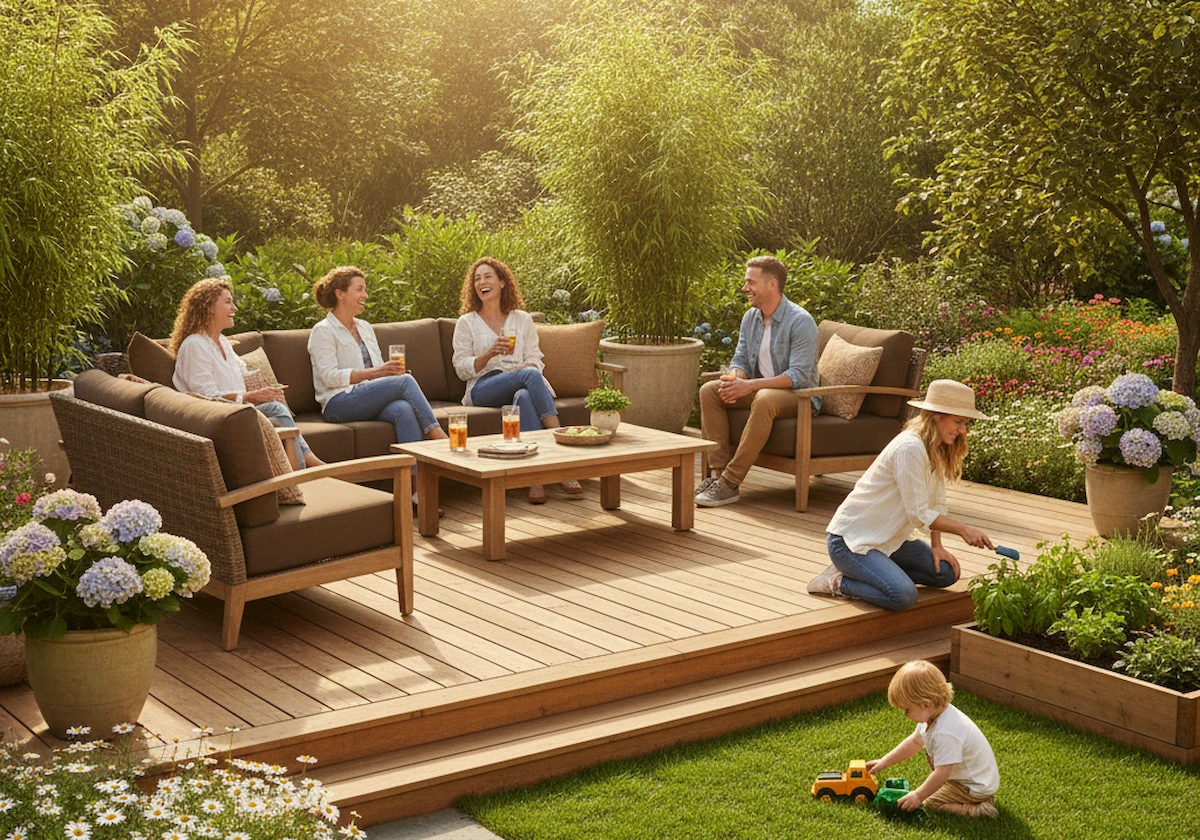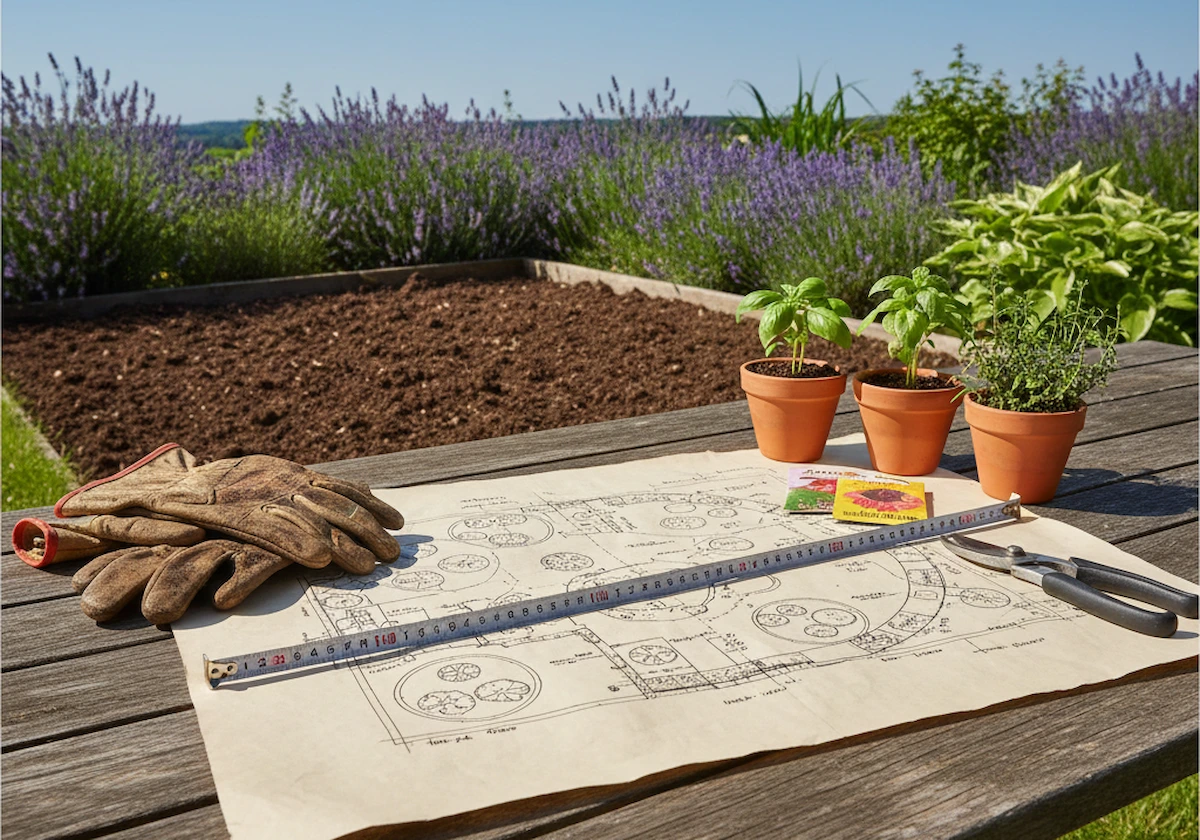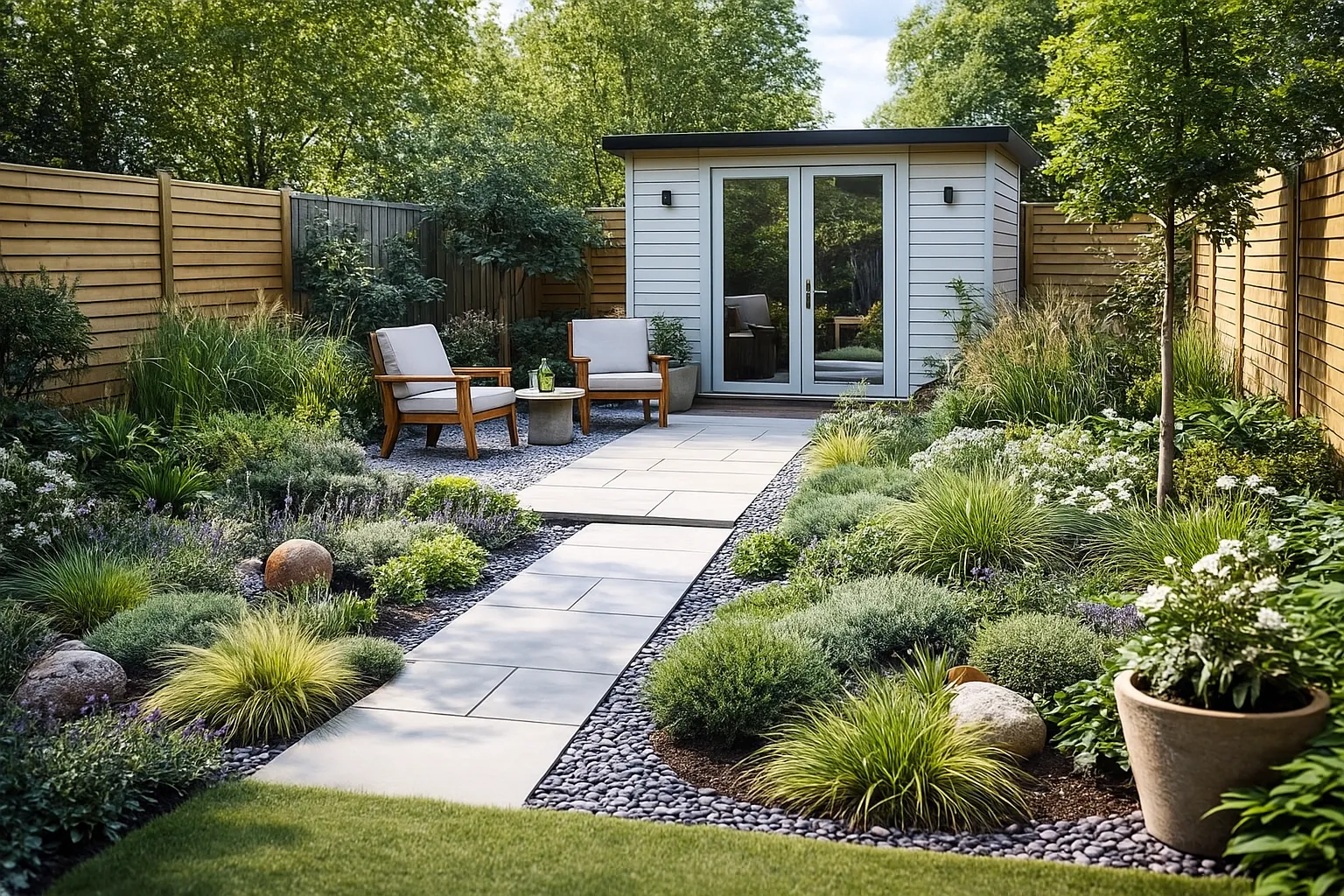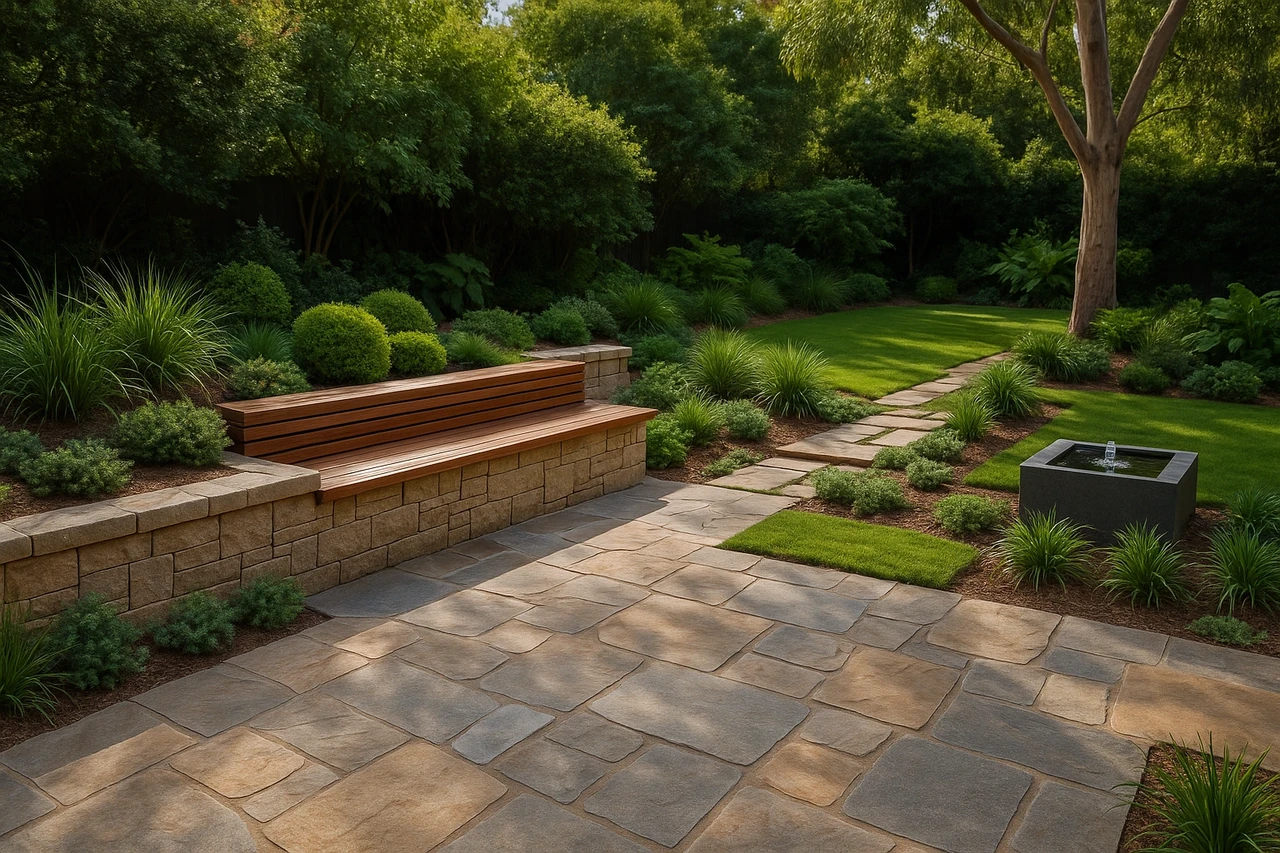The garden doesn’t need to be a chore. And it shouldn’t leave you feeling like you’re chasing your tail every week. I’ve seen too many folks burn out trying to keep up with watering schedules, chemical treatments, and finicky plants.
The truth is, the best gardens are the ones that work quietly in the background. They grow steadily, draw in butterflies, and ask for very little.
That’s the beauty of sustainable landscaping. Your garden should feel like part of your home. It should be comfortable, easy to live with, and shaped by what matters most to you.
In this guide, I’ll walk you through ways to improve soil moisture, use native plants, manage yard waste, and design your space to boost energy efficiency.
We’ll talk about ground covers, drip irrigation, and simple swaps that make your garden easier to manage and nicer to live with.
Kettle’s on. Let’s dig in.
Building a Resilient and Resource-Saving Foundation
Before you plant anything, you need to give your garden something solid to grow from. When your soil is healthy and your ground covers are well chosen, everything else in the garden gets easier. Plants grow better, water doesn’t disappear as quickly, and far less maintenance pulls you away from the good parts of gardening.
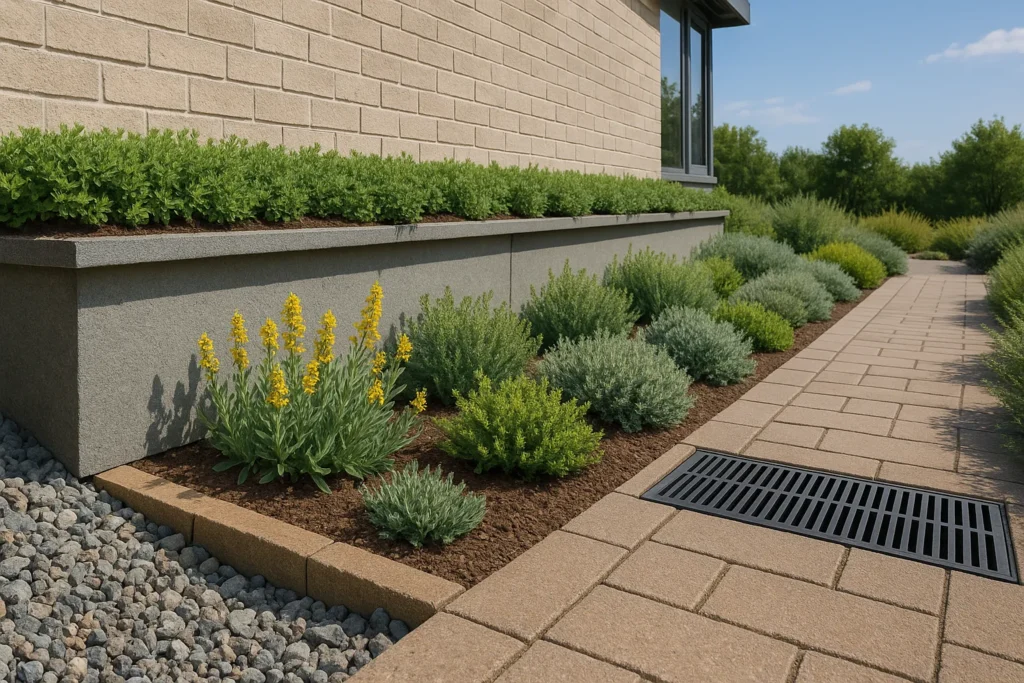
Healthy Soil: The Root of All Success
If your soil isn’t healthy, your plants won’t grow the way they should.
Every gardener I know wants healthier plants, but not everyone realises that most of the work happens underground. If your soil is tired, dry, or lifeless, even the most expensive plants won’t thrive. Luckily, it’s easy to bring your soil back to life without starting over.
- Start a compost pile using kitchen scraps, grass clippings, and autumn leaves. This creates organic matter that adds structure and nutrients to your soil.
You also keep useful material out of landfill while giving your garden exactly what it needs. - Test your existing soil with a home kit. It shows what nutrients are missing so you can add only the soil amendments you need.
Once your soil is balanced, your plants grow stronger and require fewer chemical inputs like fertilizers. - Cover the surface with wood chips or straw to hold soil moisture and stop weeds before they sprout.
- Leave the tiller in the shed. Turning soil too often harms the web of microbes and beneficial organisms that support long-term plant health.
- Good soil means fewer problems later. You’ll see better root systems, stronger growth, and much less time spent fixing issues above the surface.
Ground Covers That Do More Than Look Good
Ground covers can take care of weeds, water, and worn-out lawns without extra work from you.
I used to battle weeds across every inch of bare ground. Then I discovered native plants that crawl and sprawl with purpose. These ground covers hold moisture, smother invaders, and create a lush, soft layer that works hard without looking messy.
One of my favourites is creeping boobialla. It fills space gently and handles dry spells better than any patchy lawn. You don’t need to mow or fertilise it, and it still keeps the garden looking tidy.
When you choose well, your ground covers do more than look pretty. They support beneficial insects, prevent erosion, and reduce how often you reach for the watering can.
By planting for purpose instead of just appearance, you create a space that works better for you and the environment.
They also help maintain steady soil moisture, which keeps the rest of your garden beds in better shape. And since they shade the soil, you’ll see fewer weeds sneaking in.
Next up, we’ll look at how simple changes to your landscape design can help you save water, cool your home, and make your garden easier to enjoy all year long.
Smart Design for Sustainable and Stunning Spaces
The way your garden is laid out can either create more work or quietly solve problems before they start. A thoughtful plan helps you save water, cut down on maintenance, and make better use of what you already have. When your space works with your lifestyle and local conditions, it becomes easier to enjoy and simpler to care for.
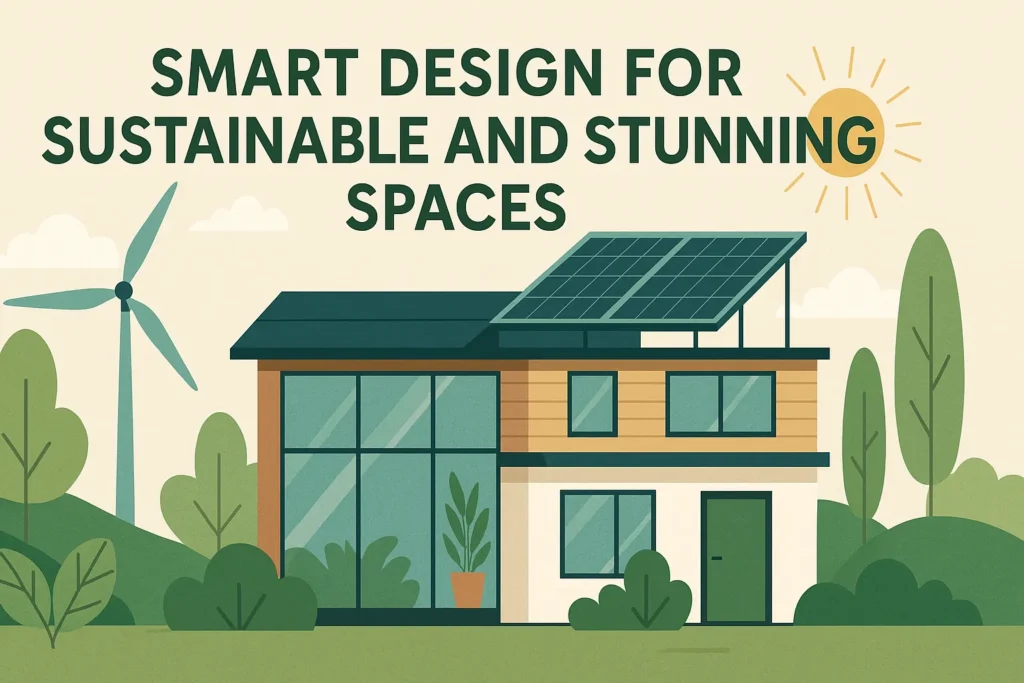
Green Landscaping Principles That Actually Work
Too many gardens are overplanted and underplanned. That’s where most of the problems start.
When you design your space with intention, you give every part of your garden a job. That means fewer surprises, less waste, and a layout that stays manageable over time.
- Start by thinking in zones. Place high-need plants close to the house where you’ll care for them often. Use drought tolerant plants further out in areas you don’t visit as much.
This approach reduces water use and saves time walking back and forth with the hose. - Use pathways and garden beds to guide the eye and make movement easier. It also helps you control where roots, water, and mulch should go.
When each area of your yard has a purpose, you’re less likely to crowd it with plants that compete for space. - Build a rain garden in low spots to manage stormwater runoff and capture nutrients.
- Skip the lawn in problem areas. Use flower beds, stone features, or even edible plants that thrive in your local climate.
The more you plan with care, the more your garden supports itself. You’ll find that your space feels calmer, cleaner, and much easier to live with.
If you’re not sure where to begin, start small and grow your ideas as you go. For extra guidance, you can explore this beginner’s guide to gardening.
Evergreen Trees with Year-Round Purpose
You’d be surprised how much a well-placed tree can change your day-to-day life. Did you know they can help lower your energy bills, block cold winds, and even make your garden feel more private?
There’s something comforting about looking out the window and seeing green, even in the middle of winter. That’s why I always recommend planting a few evergreen trees. These trees provide shade, block wind, and stay green through every season. That makes them one of the most useful plants you can add to a garden.
When planted on the north and west sides of your home, evergreens act as windbreaks. In summer, they offer shade. In winter, they buffer the cold.
This natural barrier reduces both heating and cooling costs, which adds up more than you might expect.
I like to keep it simple and local. Drought-tolerant plants such as woolly bush or native pine are lovely to look at and easy to care for. You won’t need to prune them constantly or worry about watering them every day during a heatwave.
Besides comfort and savings, they offer privacy and protection. They soften the edges of your home and help absorb noise from the street.
And because they stay green year-round, they also give structure to your landscape design when the rest of the garden is sleeping.
Think of evergreens as the bones of your garden. They anchor the space, support wildlife, and make everything else around them shine just a little more.
Next, let’s look at how smart irrigation systems and clever watering techniques can help you cut down on water use without compromising plant health.
Water-Wise Strategies That Make a Difference
It’s easy to waste water in the garden without even realising it. But with the right setup, you can give your plants what they need and not a drop more. This part of the guide covers irrigation systems that respond to your soil and weather, not just your routine.
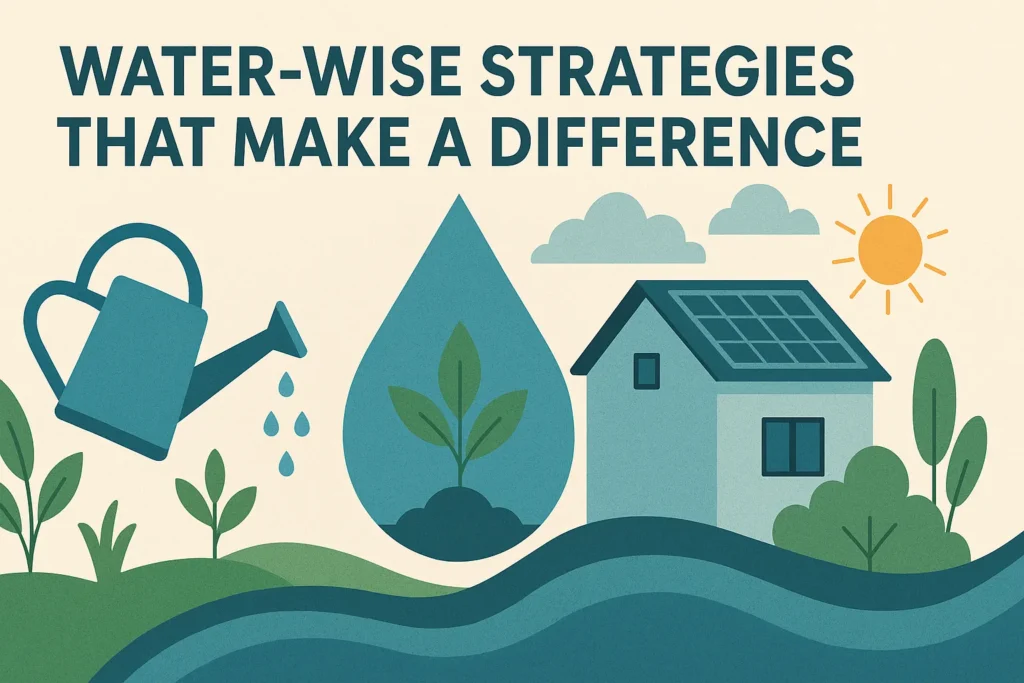
Smarter Irrigation Systems
Most sprinkler systems use more water than your garden actually needs.
You wouldn’t fill a teacup with a firehose, but that’s how many traditional systems treat the garden. With a smarter setup, you can water efficiently and let your plants thrive with less.
- Upgrade to a smart irrigation controller. These systems adjust your watering schedule based on local rain levels, temperature, and even humidity.
It’s like giving your garden its own weather-aware brain, so you don’t need to guess when to turn the tap on or off. - Install a rain sensor or soil moisture probe to pause watering when nature has already done the job.
When your system listens to your environment, you stop wasting water and start saving money. - Use efficient irrigation heads that water only where needed and not onto paths or fences.
Connect a rain barrel to your downpipes to start storing rainwater for later use during dry spells.
According to the Australian Government’s YourHome guide, up to 50% of household water use goes to the garden, and a large portion of that is lost through evaporation and runoff.
With a little planning and a few upgrades, your garden can stay green while your water bills go down. These tools pay for themselves quickly and keep your garden healthier over the long haul.
Drip Irrigation Done Right
If you want to water your plants without watering everything else, drip irrigation is the way to go.
Drip irrigation is a quiet achiever in the garden. Instead of spraying water all over, it delivers moisture directly to the base of your plants. That means less evaporation, less runoff, and far better use of your water.
- Use drip lines or soaker hoses in garden beds and along hedges. You can wind them through your rows or mulch over them to hide the tubing.
Mulching over drip lines also helps with soil moisture, making every drop go further. - Pair with a timer or smart controller for low-effort maintenance. That way, your watering happens on schedule, even if you forget.
Once it’s set up, it’s one less thing to think about on busy days or during heatwaves. - Watch out for clogs. Drip systems need occasional flushing or filter checks, especially if you’re using tank water or compost-rich soil.
- Use in containers too. Small drip emitters work well in pots, especially when grouped together in patio or balcony zones.
Drip systems are great for reducing fewer weeds, since you’re not watering everything indiscriminately. Also avoid watering leaves, which helps improve plant health and prevent disease in sensitive crops like tomatoes and herbs.
Once you see how much better your plants respond to consistent watering, you’ll wonder why you didn’t try it sooner.
Next, we’ll look at practical ways to manage loose soil and runoff with easy, effective erosion control strategies.
Taming Erosion and Battling Invasive Bullies
Every garden faces challenges from time to time. Soil slipping away with the rain or aggressive plants taking over your beds can make even the most peaceful garden feel like a battle zone. This section offers easy, non-toxic ways to fix what’s slipping and keep things under control.
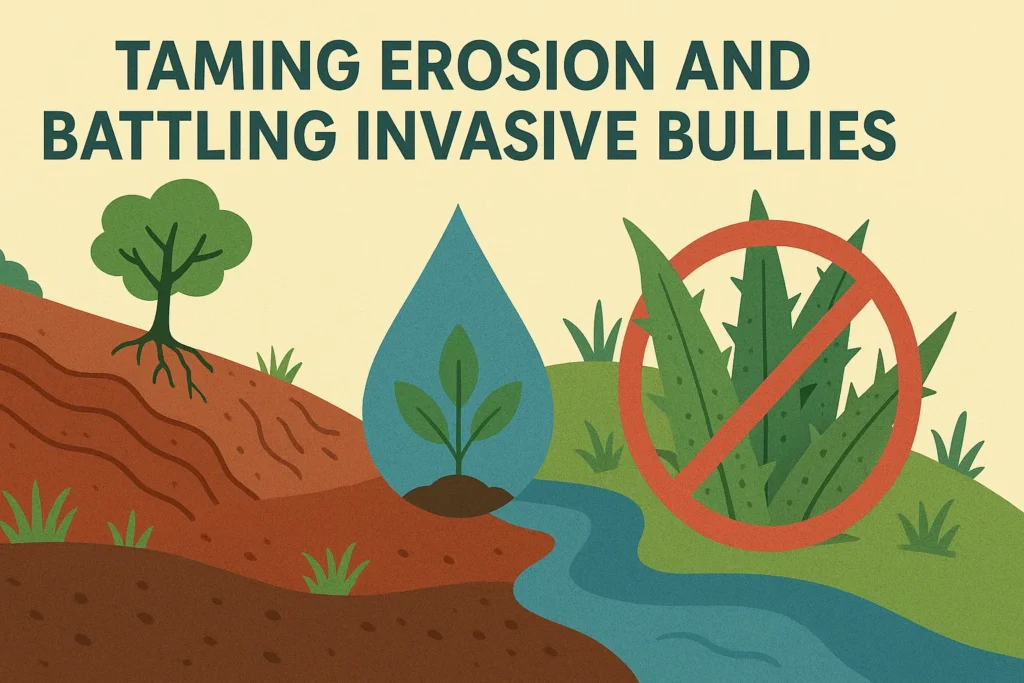
Proven Erosion Control Techniques
If you’ve watched soil wash off your slope during every storm, you’re losing more than just dirt.
Erosion can quietly undo all your hard work. It exposes roots, washes away topsoil, and leaves you with less to grow from after every heavy rain. But you don’t need big budgets or engineering solutions to fight back. Here are simple, natural ways to keep your soil where it belongs.
Break the slope
If your garden is on a hill, build gentle terraces or dig shallow swales across the slope. These act like soft speed bumps for rainwater.
They slow the flow so water soaks into the soil rather than carrying it downhill.
Let roots do the heavy lifting
Choose deep roots and native plants like lomandra, kangaroo grass, or saltbush. Their natural spread holds the Earth together with almost no help from you.
Once established, these plants handle the job without constant maintenance.
Mulch bare patches
Apply a thick layer of wood chips, straw, or other organic materials on exposed soil. This buffers the surface from wind and rain while keeping soil moisture more consistent.
Edge with intention
Place logs, stones, or edging around garden beds to stop loose soil from spilling out during storms. It also adds shape and structure to the garden’s layout.
These methods are simple, but they build resilience into your landscape. And they set you up for better drainage, better plant growth, and fewer headaches after a heavy rain.
Identifying and Managing Invasive Plants
Some plants don’t play fair, and it takes experience to know which ones are trouble.
I remember planting a cute little groundcover I picked up on sale. It spread fast, filled gaps, and seemed like a win. Then I realised it was climbing over my flower beds, choking out my herbs, and sneaking into every corner. That’s how invasives work. They look useful at first, then they take over.
Many gardeners unknowingly bring home non native species that quickly upset the balance of the yard. The key is to spot them early and act before they set deep roots or start dropping seed.
Invasive plants don’t just grow fast. They stop your soil from supporting beneficial organisms, damage plant health, and attract the wrong kind of wildlife.
When I pull out invasives now, I replace them with strong native fillers. Grevillea ground covers, fan flowers, or even hardy edible plants like warrigal greens tend to hold their ground and ask for little in return.
Once those are in place, weeds and invaders have a much harder time gaining control.
And here’s the thing. You don’t need to fight nature with chemicals. Integrated pest management is the slower, more patient method of suppressing, replacing, and redirecting. It works better in the long run and gives your garden time to stabilise naturally.
Keep a close eye on newcomers. If a plant seems too eager to grow, it might be too good to be true.
Next, we’ll look at artificial turf. It’s low-maintenance and looks tidy, but is it really sustainable? Let’s explore that together.
Alternative Landscaping That Balances Convenience with Impact
Not every garden needs a full makeover. Sometimes, choosing the right materials or layout is enough to lighten the load.
In this section, we’ll look at when artificial turf and other low-maintenance options make sense, and when they might not be the best fit.
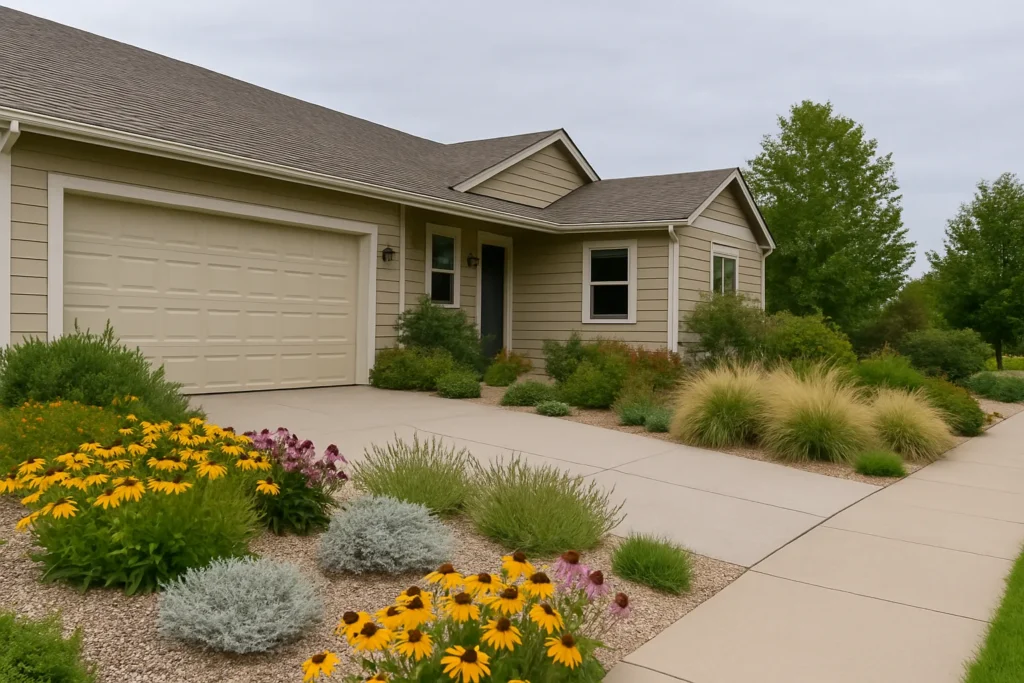
Artificial Turf: Pros, Cons, and Considerations
Artificial turf saves time, but it comes with trade-offs that many people overlook.
Where it works
If you’re dealing with a shaded corner where nothing grows, a pet run, or a high-traffic zone that gets muddy, synthetic turf might help. It stays green, never needs mowing, and won’t track dirt inside.
(Still, even when it makes sense practically, I always ask this: is it just about convenience, or could that space be used in a way that adds more life and value?)
What to watch for
Artificial turf is made from plastic and doesn’t break down. It can trap heat, leach chemicals, and block water from reaching the soil underneath, which can worsen stormwater runoff.
In summer, turf surfaces can reach over 60°C, which makes the yard feel more like a hotplate than a garden.
Better alternatives
If your goal is to reduce mowing and maintenance, there are greener choices. Ground covers, permeable gravel paths, or mixed planting beds with pots offer structure without sealing off the earth.
These materials allow rain to soak in and help your soil stay cool, moist, and full of life.
Is it worth it?
Artificial turf may seem cost efficient in the short term, but it still requires cleaning, odour control if you have pets, and full replacement every 8 to 10 years. (And when the old turf comes up, it ends up in landfill.)
There’s no shame in using it in small doses, but it’s worth weighing your reasons. Sometimes, a bit of patchy grass or wild space is better for you, your pets, and the planet.
Next, we’ll look at how your garden’s design can actually reduce your energy costs, from summer cooling to winter warmth.
Energy Efficiency Through Thoughtful Landscape Design
The plants around your home can influence how comfortable it feels inside. With thoughtful placement, they can help cool things down in summer and block cold winds in winter, which means less strain on your heating and cooling.
In this section, you’ll learn how to design a functional landscape that supports your home as well as your garden.
Plant with purpose
Planting trees near the north and west sides of your home helps reduce heat in summer and shield against cold winds in winter. This helps regulate indoor temperature naturally.
Studies have shown that strategic shade from trees can reduce energy costs by up to 30 percent in some climates.
Build natural insulation
Add a green roof or a vertical garden to outside walls. These living surfaces help insulate buildings and cool the air around them. Even a small patch of climbing plants can make a noticeable difference.
You don’t need a tall structure to benefit. Vertical gardens work just as well on fences, sheds, and balconies.
Think beyond lawn
Use shrubs, deciduous trees, and drought-tolerant plants to frame your home and reduce exposure to direct sunlight. In winter, these plants drop their leaves and let the sun in when you need it. In summer, they shade your walls and windows.
Choose the right surfaces
Paths, patios, and driveways made from permeable building materials help reduce heat buildup while allowing rain to filter into the soil. Consider pairing these with potted edible plants or shady zones to create a cooler microclimate around your home.
When you treat your garden like part of your home’s overall design, and not just something extra, you get a space that looks good and helps you live more comfortably at the same time.
Let Your Garden Grow Into Something Beautiful
It’s easy to think that sustainable landscaping has to be all or nothing, but it doesn’t. Most gardens grow better when you make one small change at a time.
You might start with a compost bin, plant one native species, or swap out part of your lawn for a few drought-hardy ground covers. Each step helps build a garden that feels good and works smarter.
Your garden doesn’t have to be perfect. It just has to make sense for your space, your lifestyle, and what you want to enjoy outside.
Over time, these small decisions add up. You’ll find yourself spending more time relaxing and less time fixing things.
If you’re ready to take the next step, there’s a full collection of ideas and guides waiting at Design Martus. You’ll find practical help, beautiful inspiration, and plenty of ways to build a garden you’re proud of.




